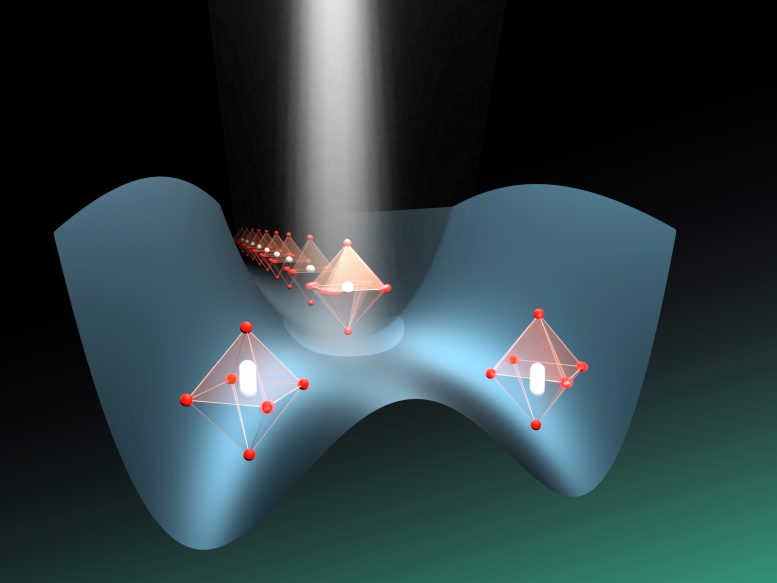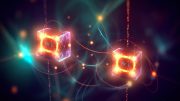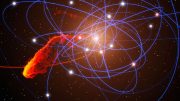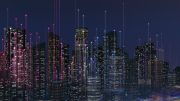
Mid-infrared light reduces the fluctuations of octahedral rotations in SrTiO3, allowing the material to transform into a ferroelectric state by shifting the central titanium ion either up or down. Credit: Jörg Harms, MPSD
Mid-infrared and terahertz laser pulses serve as potent instruments for altering the characteristics of quantum materials by specifically tailoring their crystal lattice. The induction of ferroelectricity in SrTiO3 when exposed to mid-infrared light is a significant example of this phenomenon. In this process, SrTiO3 undergoes a change to a state where electrical dipoles are permanently aligned, a condition not found in its natural state of equilibrium. The process driving this remarkable transformation remains a mystery.
Now, a team of researchers of the Max Planck Institute for the Structure and Dynamics of Matter (MPSD) in Germany and the SLAC National Accelerator Laboratory in the United States has performed an experiment at the SwissFEL X-ray Free-Electron Laser to identify the intrinsic interactions relevant to creating this state. The new insight was gained not by detecting the position of the atoms, but by measuring the fluctuations of these atomic positions.
The result provides evidence that these fluctuations are reduced, which may explain why the dipolar structure is more ordered than in equilibrium, and why a ferroelectric state could be induced. The work by the Cavalleri group has appeared in Nature Materials.
Understanding Ferroelectric Materials
Ferroelectric materials are characterized by the spontaneous parallel alignment of electric dipoles, leading to a macroscopic polarization that can point in two opposite directions. The pointing direction can be switched by an electric field, enabling the use of ferroelectrics in the digital storage and processing components of modern electronic devices.
Strontium titanate, SrTiO3, is a so-called quantum paraelectric. Unlike many of the ferroelectric materials, SrTiO3 lacks a macroscopic ferroelectric state. Yet, abundant experimental evidence shows that quantum fluctuations of the crystal lattice prevent the long-range order from developing. Surprisingly, in 2019 the Cavalleri group found that SrTiO3 transforms into a ferroelectric when certain vibrations of the crystal lattice are excited by intense pulses in the mid-infrared. The use of light to induce and control ferroelectricity at electronically inaccessible high frequencies can be envisioned as the key element of future high-speed memory applications.
Experiment and Findings
At the time, the nonlinear response of the crystal lattice was speculated to be the origin of this effect, resulting in the formation of strain that helps the material to become ferroelectric. However, direct measurements of the strain and, even more importantly, of the fluctuations of the atomic positions on the earliest timescales after the mid-IR excitation were lacking.
The researchers teamed up with Mariano Trigo’s group at SLAC and combined the mid-infrared excitation with femtosecond X-ray pulses from the SwissFEL free electron laser to shine light on these dynamics, which take place on the sub-picosecond time scale – shorter than a trillionth of a second. “In a typical X-ray diffraction experiment, one makes use of the constructive interference of the X-rays scattered from the periodically aligned atoms to measure their average positions,” says Michael Först, one of the leading authors of this work. “But here, we detected the diffuse scattering arising from disorder in the atomic arrangement which is sensitive to fluctuations, in other words noise, of the crystal lattice”.
Experimentally, the team found that the fluctuations of certain rotational modes in the SrTiO3 lattice, which obstruct the formation of long-range ferroelectricity, were rapidly reduced by the pulsed mid-infrared excitation. Such suppression does not occur in this material in equilibrium and hints at the origin of the light-induced ferroelectricity. This was confirmed by a rigorous theoretical analysis that revealed complex, high-order interactions between a set of lattice vibrations and the strain as the source of these observations. Michael Fechner, the theorist of this project, emphasizes the importance of the collaboration between theory and experiment: “It allows us to sharpen our tools for predictions and, consequently, to enhance our understanding of matter and its interactions with light.”
Implications and Future Prospects
Andrea Cavalleri, group leader and director at the MPSD, foresees new opportunities arising from this study: “The fact that certain lattice fluctuations, which prevent the formation of long-range ferroic order, can be suppressed by dynamic means is new and offers possibilities for similar behavior in other quantum materials. Furthermore, as our group studies induced order in other settings, including magnetic and superconducting, the results discussed here may have wider implications beyond the physics of SrTiO3.”
Reference: “Quenched lattice fluctuations in optically driven SrTiO3” by M. Fechner, M. Först, G. Orenstein, V. Krapivin, A. S. Disa, M. Buzzi, A. von Hoegen, G. de la Pena, Q. L. Nguyen, R. Mankowsky, M. Sander, H. Lemke, Y. Deng, M. Trigo and A. Cavalleri, 1 February 2024, Nature Materials.
DOI: 10.1038/s41563-023-01791-y
The research at the MPSD received financial support from the Deutsche Forschungsgemeinschaft via the Cluster of Excellence CUI: Advanced Imaging of Matter. The MPSD Matter is a member of the Center for Free-Electron Laser Science (CFEL), a joint enterprise with DESY and the University of Hamburg.









Michael Fechner, the theorist of this project, emphasizes the importance of the collaboration between theory and experiment.
very good!
Please answer:
1. Where does the dipole structure come from?
2. Why is the dipolar structure more ordered than in equilibrium?
3. Is chaos balanced?
4. Which is more in equilibrium between order and disorder?
5. Can topological vortices and their antivortices form complex spacetime structures through interaction and self-organization?
and so on.
The universe does not do algebra, formula or fraction, the universe is geometry.
Today, we have already entered the era of the internet. With the help of artificial intelligence and big data, discussions on scientific knowledge have become open and transparent. However, a group of editors of so-called academic journals (such as Physical Review Letters, Nature, Science, etc.) are self-righteous and mystifying themselves. They only care about their own so-called sufficiently high priority rating, general significance, discipline, novelty, etc., and do not care about what science and pseudoscience are.
Science and pseudoscience are not determined by a publication, an organization or a person, nor by you or me, but by mathematics the final say. Physical models must be based on mathematics or mathematical models in order to be scientific, convincing, and in accordance with natural laws.
The branch of geometry (mathematics) known as topology has become a cornerstone of modern physics. Topological vortex and antivortex are two bidirectional coupled continuous chaotic systems. They exhibit parity conservation, charge conjugation, and time reversal symmetry. The synchronization effect is extremely important in their interactions. The synchronization effect of the superposition, deflection, and twisting of multiple or countless topological vortices will make spacetime motion more complex. To understand this complex world, physics should respect the authenticity of topological vortex in low dimensional spacetime, rather than simply relying on a few formulas, numbers, or imagined particles.
Spin is a natural property of topological vortices. Spin is synchronized with energy, spin is synchronized with gravitation, spin is synchronized with time, spin is synchronized with evolution. The perpetually swirling topological vortices defy traditional physics’ expectations. One physical properties of topological vortices is them to spontaneously begin to change periodically in time, even though the system does not experience corresponding periodic interference. Therefore, in the interaction of topological vortices, time is both absolute and relative,and physics often requires treating space and time at the same level.
Low-dimensional spacetime matter is the foundation of high-dimensional spacetime matter. Low-dimensional spacetime matter (such as topological vortex) can form new material structures and derive more complex physical properties via interactions and self-organization. It is extremely wrong and irresponsible to imagine low dimensional spacetime matter using high-dimensional spacetime matter.
Please answer:
What is the difference between topological vortices and perpetual motion machines?
Science must follow mathematical rules. For example, the Standard Model (SM) is considered to be one of the most significant achievements of physics in the 20th century. However, the magnetic moment of μ particle is larger than expected, revealed by a g-2 experiment at Fermilab, suggests that the established theory (such as SM) of fundamental particles is incomplete. Furthermore, the SM omitting gravitation, it not involved the time problem and when the particle movement starts. Mathematics is the foundation of science. Physics must respect the scientific nature of mathematics and mathematical models. The SM must be based on mathematical models in order to be scientific, convincing, and in line with natural laws.
I hope researchers are not fooled by the pseudoscientific theories of the Physical Review Letters (PRL), and hope more people dare to stand up and fight against rampant pseudoscience.
The so-called academic journals (such as Physical Review Letters, Nature, Science, etc.) firmly believe that two high-dimensional spacetime objects (such as two sets of cobalt-60) rotating in opposite directions can be transformed into two objects that mirror each other, is a typical case of pseudoscience rampant.
If researchers are really interested in Science and Physics, you can browse https://zhuanlan.zhihu.com/p/643404671 and https://zhuanlan.zhihu.com/p/595280873.
The more you churn out “quantum” stuff in your magazine, the more I’m convinced the whole quantum thing is just one sad joke.